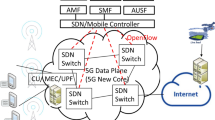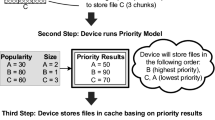Abstract
In this paper, we present an architecture to improve video streaming quality of experience (QoE) in cellular networks with high user equipment (UE) density. In the proposed architecture, video segments are progressively cached, as requested, in selected UEs called storage members (SMs). Video segments are strategically cached to be available to requesting users in the cell. Furthermore, the base-station controls the device-to-device communication between the UEs to provide collaborative peer-to-peer transmission of video segments. Dynamic adaptive streaming over HTTP is also employed to adapt the quality of video segments to network conditions. We study the improvements achieved by the proposed architecture in terms of many video streaming QoE metrics. Thereafter, we improve the operation of the proposed architecture by introducing QoE awareness to both caching and distribution of video segments. We employ QoE awareness in three aspects of the proposed architecture; cellular resource allocation, caching of video segments, and SM-assignment optimization. We analyze the improvements achieved by the prospered QoE-awareness techniques in terms of video streaming QoE metrics.






Similar content being viewed by others
References
Ooyala (2018) Ooyala’s Q4 2017 Global Video Index. http://go.ooyala.com/wf-video-index-q4-2017. Accessed 10 Oct 2018.
Sandvine (2016) 2016 Global internet phenomena: Latin America and North America. Technical report.
Brunnström, K., Beker, S. A., De, K., et al. (2014). Qualinet white paper on definitions of quality of experience. European Network on Quality of Experience in Multimedia Systems and Services (COST Action IC 1003), Lausanne, Switzerland.
Seufert, M., Egger, S., Slanina, M., et al. (2015). A survey on quality of experience of HTTP adaptive streaming. IEEE Communications Surveys & Tutorials,17, 469–492.
ITU. (2016). Vocabulary for performance and quality of service. ITU-T Recommendation P.10, Amendment 5.
El, Essaili A., Schroeder, D., Steinbach, E., et al. (2015). QoE-based rraffic and resource management for adaptive HTTP video delivery in LTE. IEEE Transactions on Circuits and Systems for Video Technology,25, 988–1001.
Cicalo, S., Changuel, N., Tralli, V., et al. (2016). Improving QoE and fairness in HTTP adaptive streaming over LTE network. IEEE Transactions on Circuits and Systems for Video Technology,26, 2284–2298.
Huang, T.-Y., Johari, R., McKeown, N., et al. (2014). A buffer-based approach to rate adaptation: Evidence from a large video streaming service. In Proceedings of the 2014 ACM SIGCOMM (pp. 187–198). New York, USA: ACM.
De Cicco, L., & Mascolo, S. (2014). An adaptive video streaming control system: Modeling, validation, and performance evaluation. IEEE/ACM Transactions on Networking,22, 526–539.
Keller, L., Le, A., Cici, B., et al. (2012). MicroCast: Cooperative video streaming on smartphones. In the 10th international conference on mobile systems, applications, and services (pp 57–70). New York, USA.
Detti, A., Ricci, B., & Blefari-Melazzi, N. (2015). Mobile peer-to-peer video streaming over information-centric networks. Computer Networks,81, 272–288.
Al-Habashna, A., Wainer, G., & Fernandes, S. (2017). Improving video streaming over cellular networks with DASH-based device-to-device streaming. In 2017 international symposium on performance evaluation of computer and telecommunication systems (pp. 468–475). Seattle, USA: IEEE.
Al-Habashna, A., Wainer, G., Boudreau, G., & Casselman, R. (2015). Improving wireless video transmission in cellular networks using D2D communication.
Al-Habashna, A., Wainer, G., Boudreau, G., & Casselman, R. (2016). Distributed cached and segmented video download for video transmission in cellular networks. In 2016 international symposium on performance evaluation of computer and telecommunication systems (pp. 473–480). Montreal, Canada: IEEE.
Al-Habashna, A., & Wainer, G. (2017). Improving video transmission in cellular networks with cached and segmented video download algorithms. Mobile Networks and Applications,23, 543–559.
Li, B., Wang, Z., Liu, J., & Zhu, W. (2013). Two decades of internet video streaming. ACM Transactions on Multimedia Computing, Communications, and Applications,9, 1–20.
Stockhammer, T. (2011). Dynamic adaptive streaming over HTTP: Standards and design principles. In Proceedings of the 2nd annual ACM conference on multimedia systems (pp. 133–144). New York, USA: ACM Press.
DASH Industry Forum. (2013). Guidelines for implementation: DASH-AVC/264 interoperability points. http://dashif.org/wp-content/uploads/2015/04/DASH-AVC-264-base-v1.03.pdf. Accessed 28 Feb 2018.
Tian, G., Liu, Y. (2012). Towards agile and smooth video adaptation in dynamic HTTP streaming. In Proceedings of the 8th international conference on emerging networking experiments and technologies (pp. 109–120). Nice, France: ACM Press.
De Cicco, L., Caldaralo, V., Palmisano, V., & Mascolo, S. (2013). ELASTIC: A client-side controller for dynamic adaptive streaming over HTTP (DASH). In 20th international packet video workshop (pp. 1–8). San Jose, USA: IEEE.
Conviva. (2013). Conviva releases viewer experience report. https://www.conviva.com/press-releases/conviva-releases-viewer-experience-report/. Accessed 10 June 2018.
Mok, R. K. P., Chan, E. W. W., Luo, X., & Chang, R. K. C. (2011). Inferring the QoE of HTTP video streaming from user-viewing activities. In Proceedings of the 1st ACM SIGCOMM workshop on measurements up the stack (pp. 31–36). Toronto, Canada: ACM Press.
Hossfeld, T., Egger, S., Schatz, R., et al. (2012). Initial delay vs. interruptions: Between the devil and the deep blue sea. In 4th international workshop on quality of multimedia experience (pp. 1–6.). Yarra Valley, Australia: IEEE.
Qi, Y., & Dai, M. (2006). The effect of frame freezing and frame skipping on video quality. In 2006 international conference on intelligent information hiding and multimedia (pp. 423–426). Pasadena, USA: IEEE.
Sackl, A., Egger, S., & Schatz, R. (2013). Where’s the music? Comparing the QoE impact of temporal impairments between music and video streaming. In 5th international workshop on quality of multimedia experience (pp. 64–69). Klagenfurt am Wörthersee, Austria: IEEE.
3GPP. (2015). Evolved universal terrestrial radio access: Physical channels and modulation. Technical report TS 36.211.
Agiwal, M., Roy, A., & Saxena, N. (2016). Next generation 5G wireless networks: A comprehensive survey. IEEE Communications Surveys & Tutorials,18, 1617–1655.
Asadi, A., Wang, Q., & Mancuso, V. (2014). A survey on device-to-device communication in cellular networks. IEEE Communications Surveys & Tutorials,16, 1801–1819.
Kaufman, B., & Aazhang, B. (2008). Cellular networks with an overlaid device to device network. In the 42nd Asilomar conference on signals, systems and computers (pp. 1537–1541). Pacific Grove, USA: IEEE.
Doppler, K., Rinne, M. P., Janis, P., et al. (2009). Device-to-device communications; functional prospects for LTE-advanced networks. In IEEE international conference on communications workshops (pp. 1–6). Dresden, Germany: IEEE.
Duan, L., Gao, L., & Huang, J. (2014). Cooperative spectrum sharing: A contract-based approach. IEEE Transactions on Mobile Computing,13, 174–187.
Zhang, Y., Song, L., Saad, W., et al. (2015). Contract-based incentive mechanisms for device-to-device communications in cellular networks. IEEE Journal on Selected Areas in Communications,33, 2144–2155.
Le, A., Keller, L., Seferoglu, H., et al. (2016). MicroCast: Cooperative video streaming using cellular and local connections. IEEE/ACM Transactions on Networking,24, 2983–2999.
Eittenberger, P. M., Herbst, M., & Krieger, U. R. (2012). RapidStream: P2P streaming on android. In 2012 19th international packet video workshop (pp. 125–130). Munich, Germany: IEEE.
Duong, T. Q., Vo, N.-S., Nguyen, T.-H., et al. (2015). Energy-aware rate and description allocation optimized video streaming for mobile D2D communications. In 2015 IEEE international conference on communications (pp. 6791–6796). London, UK: IEEE.
Kim, J., Caire, G., & Molisch, A. F. (2016). Quality-aware streaming and scheduling for device-to-device video delivery. IEEE/ACM Transactions on Networking,24, 2319–2331.
Zhu, H., Cao, Y., Wang, W., et al. (2015). QoE-aware resource allocation for adaptive device-to-device video streaming. IEEE Network,29, 6–12.
Ghalut, T., Larijani, H., & Shahrabi, A. (2016). QoE-aware optimization of video stream downlink scheduling over LTE networks using RNNs and genetic algorithm. Procedia Computer Science,94, 232–239.
Lee, G., Kim, H., Cho, Y., & Lee, S.-H. (2014). QoE-aware scheduling for sigmoid optimization in wireless networks. IEEE Communications Letters,18, 1995–1998.
Kolding, T. (2006). QoS-aware proportional fair packet scheduling with required activity detection. In 64th IEEE vehicular technology conference (pp. 1–5). Montreal, Canada: IEEE.
Fodor, G., Dahlman, E., Mildh, G., et al. (2012). Design aspects of network assisted device-to-device communications. IEEE Communications Magazine,50, 170–177.
Gurobi Optimization. (2018). Gurobi optimization—The state-of-the-art mathematical programming solver. http://www.gurobi.com/index. Accessed 29 May 2018.
Wainer, G. A. (2009). Discrete-event modeling and simulation: A practitioner’s approach. Boca Raton: CRC Press.
3GPP. (2015). Evolved universal terrestrial radio access; RF system scenarios. Technical report TR36.942.
Al-Hourani, A., Chandrasekharan, S., & Kandeepan, S. (2014). Path loss study for millimeter wave device-to-device communications in urban environment. In 2014 IEEE international conference on communications workshops (pp. 102–107). Sydney, Australia: IEEE.
Dahlman, E., Parkvall, S., & Sköld, J. (2014). 4G LTE/LTE-advanced for mobile broadband (2nd ed.). Amsterdam: Elsevier.
Kilinc, C., Ericson, M., Rugeland, P., et al. (2017). 5G multi-RAT integration evaluations using a common PDCP layer. In IEEE 85th vehicular technology conference (pp. 1–5). Sydney, Australia.
3GPP. (2016). Study on new radio access technology: Radio access architecture and interfaces. Technical report 38.801.
Cha, M., Kwak, H., Rodriguez, P., et al. (2007). I tube, you tube, everybody tubes. In Proceedings of the 7th ACM SIGCOMM conference on internet measurement (pp 1–14). New York, USA: ACM Press.
ITU-T. (2012). Infrastructure of audiovisual servicescoding of moving video. ITU-T Recommendation H.264.
Ahsan, S., Singh, V., & Ott, J. (2014). Characterizing internet video for large-scale active measurements. arXiv preprint arXiv:14085777v1.
Acknowledgements
The authors would like to thank Dr. Stenio Fernandes from the Federal University of Pernambuco, Brazil, for his valuable assistance during this work.
Author information
Authors and Affiliations
Corresponding author
Additional information
Publisher's Note
Springer Nature remains neutral with regard to jurisdictional claims in published maps and institutional affiliations.
Rights and permissions
About this article
Cite this article
Al-Habashna, A., Wainer, G. QoE awareness in progressive caching and DASH-based D2D video streaming in cellular networks. Wireless Netw 26, 2051–2073 (2020). https://doi.org/10.1007/s11276-019-02055-x
Published:
Issue Date:
DOI: https://doi.org/10.1007/s11276-019-02055-x




